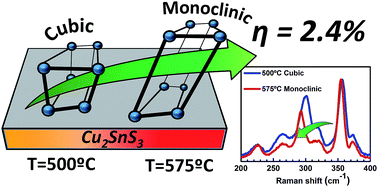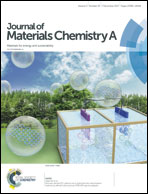Characterization of Cu2SnS3 polymorphism and its impact on optoelectronic properties
Abstract
Earth abundant compounds are of interest as a possible alternative to more mature thin film based technologies. Cu2SnZnSe4 (CZTS) is the most studied material but its development is impeded by an easy formation of secondary phases, decomposition effects during both synthesis and post process treatments, and formation of Cu–Zn defects resulting in limited device performance. In this context, Cu2SnS3 (CTS) is an interesting substitute with suitable optoelectronic properties and a wider stable composition range with fewer constituents hence (avoiding Zn related defects). Currently the technology is still in an early stage of development with a 4.63% record efficiency (6% with an alloy with Ge) and faces serious issues related to the formation and coexistence of different polymorphic/stoichiometric phases indicating that precise composition control and phase identification are still needed. In this work, an analysis of CTS thin film absorbers is presented. A comparative study by X-ray diffraction profile refinement and Raman spectroscopy allowed the assessment of both cubic and monoclinic CTS phases formed at different annealing temperatures. In addition Raman analysis of precursors sulfurized at different temperatures revealed a blue shift as well as a reduction of the Full Width at Half Maximum (FWHM) of the two dominant peaks for temperatures close to 550 °C, which is interpreted as a CTS phase transition in the absorber layer. This alteration was also correlated with the optoelectronic properties of devices. A higher Voc and Jsc are obtained for samples with 30% monoclinic CTS phase concentration which led to a record efficiency of 2.4%. It is then assumed that higher efficiencies could be achieved for a pure monoclinic CTS layer. In this sense, a non-destructive methodology for the fast evaluation of cubic Cu2SnS3 formation at the surface is proposed.

- This article is part of the themed collection: 2017 Journal of Materials Chemistry A HOT Papers


 Please wait while we load your content...
Please wait while we load your content...